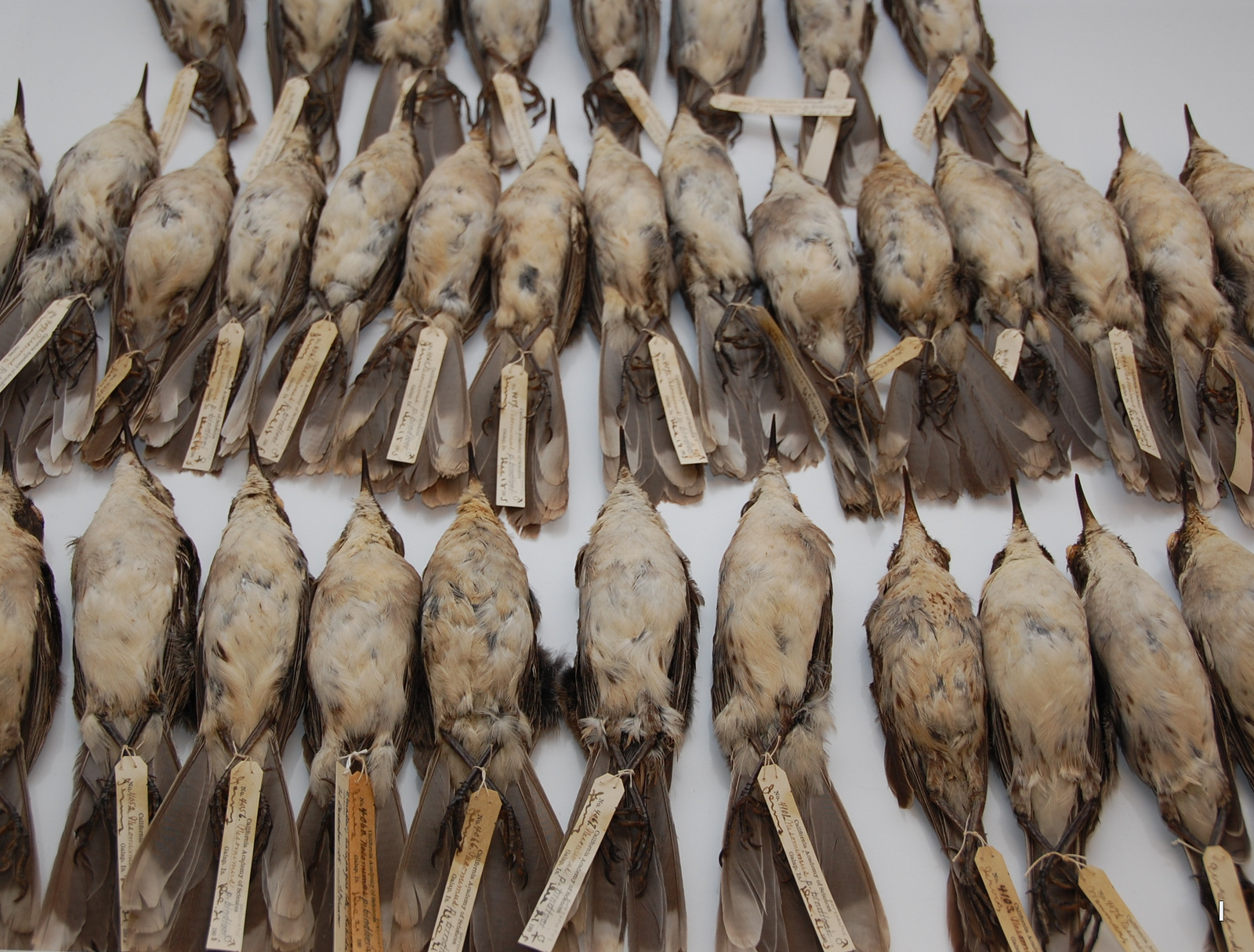

The smell in the collections room immediately brings back very good memories. When I first visited the California Academy of Sciences in 2007, their collection was temporarily housed in a different facility. Now I am standing in a room of a spectacular modern building in Golden Gate Park, San Francisco. The location may be different, but the smell hasn’t changed. Ten thousands of bird and mammal specimens from all over the world are stored here.
My mission is also almost the same. I am here for the Galápagos mockingbirds, the birds that have been the center of my scientific interest for many years now. Moe Flannery, the collections manager, guides us through the narrow hallway lined with massive cabinets. I am accompanied by my friend and colleague Tandora Grant. We need to find a very specific drawer, one that carries the tag ‘Mimus parvulus’ and contains the specimens of the two Galápagos mockingbird subspecies ‘wenmani’ and ‘hulli’. Moe successfully locates a few ‘Mimus parvulus’ drawers, but as we look through the nametags of the specimens inside, we read ‘personatus’, ‘barringtoni’, ‘bauri’… Not the right ones. I am still delighted by their sight; it feels a little bit like seeing old friends.
When I came here in 2007 as a Ph.D. student, I spent a few days with these birds, working on 349 of them. Some of them look different from each other. Millennia of living on isolated islands have shaped these birds into different species and subspecies – like the Darwin’s finches that have become a textbook example in evolutionary biology. But it was actually the mockingbirds’ distinct look on different islands that gave Charles Darwin his first vital clue for his theory of speciation under natural selection.
The birds we are looking at, lined up side-by-side, belly-up and legs crossed, are all well over 100 years old. The nametag on their legs specifies their origin and species’ name. Because the taxonomic knowledge has changed since their collection, many actually carry two or three tags with updated information. We can’t see ‘hulli’ or ‘wenmani’ anywhere. “Every once in a while we get unlucky,” Moe says before she takes off to get a tall ladder on wheels that resembles a portable staircase. She climbs to the very top and pulls out the top drawer. Back down on safe ground she asks, “Is Culpepper what you’re looking for?” I feel immediately embarrassed—I’ve forgotten the islands’ old names! Like the birds, the islands were renamed several times over the last century. Tandora grabs her iPhone and Google’s Culpepper. Yes, it is Darwin Island, and birds from Wenman, now called Wolf Island, lie in the same drawer. We found what we came for!
Darwin and Wolf islands are the most remote of the Galápagos Islands, separated from the rest of the archipelago by a stretch of almost 100 miles of open ocean. For a somewhat flight-lazy bird, like the mockingbirds, such vast open water with no other islands in sight is probably quite an effective deterrent to emigration. That’s at least my hypothesis and the reason why these specimens, now neatly placed in front of us, are of so much interest to me.
I’ve studied these birds for many years now. I spent many months in the Galápagos and visited almost all islands to collect blood samples from the different mockingbird species and populations. A little drop of blood from a couple of dozen birds from each island was all I needed to let them tell me about their interisland traveling habits. The birds’ genetic information gave me insights into their population sizes and their relationship between different islands. The analysis of the historic specimens that I sampled at the Academy in 2007 added an interesting timely perspective; it revealed which island populations have changed the most over the last century.
I take out my sample collection material. These specimens from Darwin and Wolf escaped my scalpel blade last time. At the time, it was uncertain whether I would be able to obtain contemporary samples of their subspecies. Now their time has come. I pick up the first specimen and cut a tiny piece of tissue sample from one of the toe pads. One specimen down! The spot on the foot where the sample was taken is barely visible. Minimal damage to the specimen, but lots of new information to be gained.
The historic samples we’ve just collected are the first step in the discovery of the genetic secrets of these two remote populations. Together with collaborators, I am planning to climb onto Darwin and Wolf islands early next year to collect blood samples from living birds. The islands are infamous for their inaccessibility, but we’ll have an excellent team at hand. Let the adventure begin!
By Paquita Hoeck, Ph.D., San Diego Zoo Institute for Conservation Research.


